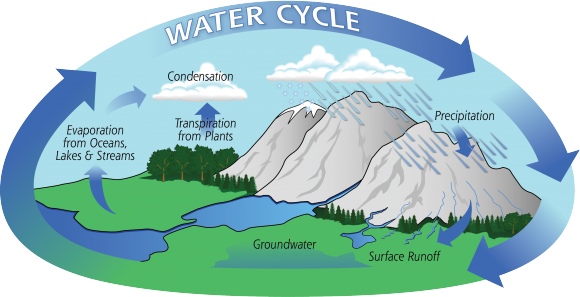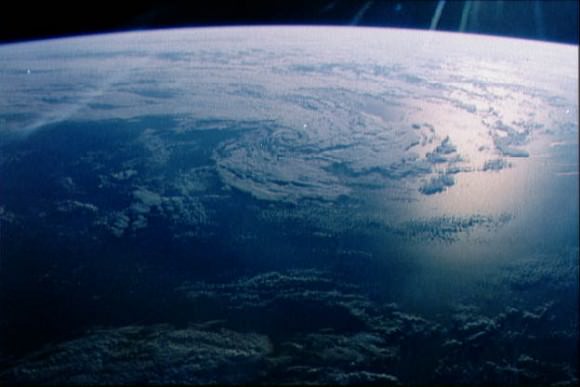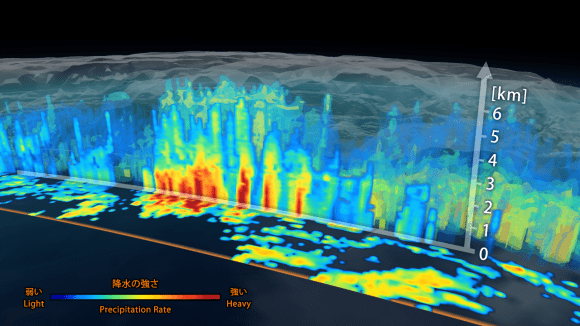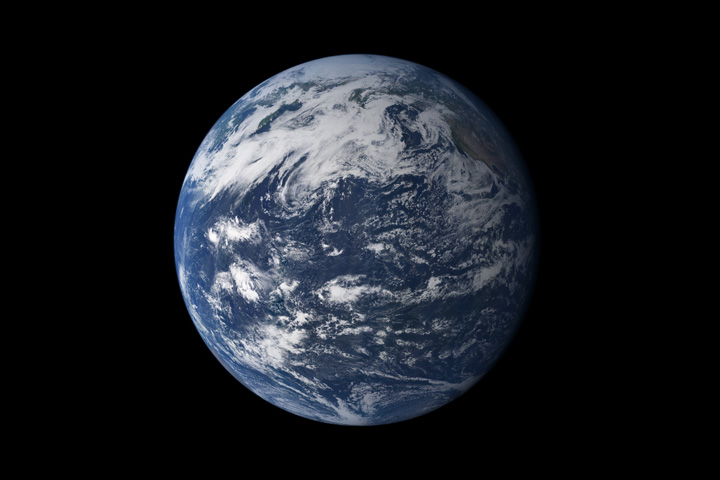Precipitation is much more widespread throughout that solar system than commonly assumed. Obviously it rains water on Earth. But it snows carbon dioxide on Mars, rains methane on Titan, sulfuric acid on Venus, and could potentially rain diamonds on Neptune. The type of material falling out of the sky is almost as varied as the planets themselves. New research from a team led by Kaitlyn Loftus at Harvard found a similarity for all of the liquid materials that constitute rain throughout the solar system – all of the drops, no matter the material, are roughly the same size.
Continue reading “What Would Raindrops be Like on Other Worlds?”How Would Rain be Different on an Alien World?

On Titan, Saturn’s largest moon, it rains on a regular basis. As with Earth, these rains are the result of liquid evaporating on the surface, condensing in the skies, and falling back to the surface as precipitation. On Earth, this is known as the hydrological (or water) cycle, which is an indispensable part of our climate. In Titan’s case, the same steps are all there, but it is methane that is being exchanged and not water.
In recent years, scientists have found evidence of similar patterns involving exoplanets, with everything from molten metal to lava rain! This raises the question of just how exotic the rains may be on alien worlds. Recently, a team of researchers from Havard University conducted a study where they researched how rain would differ in a diverse array of extrasolar planetary environments.
Continue reading “How Would Rain be Different on an Alien World?”Why Does it Rain?
Many people love to ask, why does it always rain on me? There are those who would like to know why it rains so much when they are sad, when they feel like going out, or only when they decide to jog or take their pet for a walk. There are no easy answers for these arguably subjective questions. However, if one to ask “why does it rain”, the answer would be much simpler.
For starters, rain is liquid precipitation, as opposed to non-liquid kinds (such as snow, hail and sleet). It begins with the vaporization of water near the Earth’s surface, in the form of rivers, lakes, oceans or ground water, provided there are atmospheric temperatures above melting point of water (0°C). This is followed by the condensation of atmospheric water vapor into drops of water that are heavy enough to fall, often making it to the surface.
Precipitation is also a major component of the hydrological cycle – aka. “water cycle“. This is the term used to describe the continuous movement of water on, above, and below the Earth, and is responsible for depositing most of the fresh water on the planet. Rain occurs when two basic processes occur: Saturation and Coalescence.

Saturation:
This process occurs when “invisible” moisture in the air (water vapor) is forced to condense on microscopic particles (i.e. pollen and dust) to form tiny “visible” droplets. The amount of moisture in air is also commonly reported as relative humidity; which is the percentage of the total water vapor air can hold at a particular air temperature.
How much water vapor a parcel of air can contain before it becomes saturated (100% relative humidity) and forms into a cloud (a group of visible and tiny water and ice particles suspended above the Earth’s surface) depends on its temperature. Warmer air can contain more water vapor than cooler air before becoming saturated.
Coalescence:
Condensation occurs when the air is cooled down to its “dew point” temperature – the point at which it becomes saturated. Coalescence occurs when water droplets fuse to create larger water droplets (or when water droplets freeze onto an ice crystal) which is usually the result of air turbulence which forces collisions to occur.
As these larger water droplets descend, coalescence continues, so that drops become heavy enough to overcome air resistance and fall as rain. Rain is the primary source of freshwater for most areas of the world, providing suitable conditions for diverse ecosystems, as well as water for hydroelectric power plants and crop irrigation.

Measurement:
Rainfall is measured through the use of rain gauges. These gauges typically consist of two cylinders, one within the other, that fill with water. The inner cylinder fills first, with overflow entering the outer cylinder. Once the inner cylinder is filled, it is emptied and then filled with the remaining rainfall in the outer cylinder, producing a total estimate in millimeters or inches.
Other types of gauges include the popular wedge gauge, the tipping bucket rain gauge, and the weighing rain gauge. The most inexpensive option is a simple cylinder with a measuring stick, provided the cylinder is straight and the measuring stick is accurate. Any of these gauges can be made at home, with the right kind of knowledge.
Precipitation amounts are also estimated actively by weather radar, and passively by weather satellites. Examples of the latter include the Tropical Rainfall Measuring Mission (TRMM) satellite – a joint mission conducted by NASA and the Japanese Space Agency to monitor precipitation in the tropics – and NASA’s Global Precipitation Measurement (GPM).
Both of these mission employ microwave sensors to create precipitation estimates. Annual precipitation data is collected and monitored by NASA’s Earth Observatory (NEO), which creates detailed maps of global weather patterns (as well as heating and other meteorological factors).

Climate Change:
Anthropocentric Climate Change, which includes Global Warming, is also causing changes in global precipitation patterns. This is due to the fact that increases in carbon dioxide emissions have led to increasing annual temperatures around the globe, leading to more evaporation and precipitation and more extreme weather events.
At latitudes north of 30°, precipitation has increased over the past century, while similarly declining over the tropics since the 1970s. And while there has been no consistent change on a global scale, regional variations have been pronounced. For instance, eastern portions of North and South America, northern Europe, and northern and central Asia have become wetter.
Other regions, such as the Sahel (between the Sahara desert and the Sudanian Savanna), the Mediterranean, southern Africa and parts of southern Asia have become drier. There has also been an increase in both the number of heavy rainstorms and droughts over many areas in the past century. In the tropics and subtropics, there has also been an increase in the prevalence of droughts since the 1970s.
Rain on Other Planets:
Despite what you might think, Earth is not the only planet where rain occurs. On other bodies in the Solar System, liquid precipitation takes place, though it rarely involves water. In fact, on Venus, rain regularly occurs, except that it involves sulfuric acid!
This acid rain is formed high in the atmosphere, where the wind speeds get up to 360 kilometers/hour (224 mph). However, once the droplets reach the lower atmosphere, they evaporate due to the extreme heat – over 460 °C or 860 °F. Hence, the rain never reaches the surface, which is extremely dry and molten.
On Saturn’s moon Titan, rain takes the form of methane. As evidence provided by the Cassini-Huygens mission has indicated, the moon has an active hydrological cycle. Except that Titan’s involves liquid hydrocarbons instead of water. As part of this cycle, liquid methane evaporates on the surface, accumulates in the atmosphere, and then returns to the surface as seasonal rains.
But it gets weirder! For instance, in recent years, scientists have obtained experimental evidence that indicates that Jupiter and Saturn may experience liquid helium rain. Due to the extreme pressure conditions that exist within the gas giants interior, these gases are compressed to the point where they take liquid form.
And then there’s what is known as “diamond rain”, which has been speculated to exist on all the gas giants. Essentially, Jupiter, Saturn, Uranus and Neptune all possess methane in their interiors. Due to the extreme pressure conditions, these hydrocarbons are compressed to the point that actual diamonds are believed to form. As such, diamond rain may actually exist in these gas/ice giants.
Last, but not least, there is the curious case of “Coronal Rain“, which takes place on the Sun. This phenomena occurs during a coronal mass ejection, where plasma cools after being ejected and falls back to the surface. Sometimes, these plasma droplets makes ‘splashes’ where they hit. And instead of falling straight down, the plasma rain appears to follow the path of the Sun’s invisible magnetic field lines.
Here on Earth, rain takes the form of water, and is an intrinsic part of our hydrological cycle. On other worlds, rain can take a different form, but still occupies much the same place in the planet’s cycle. Due to changing temperatures, saturation and coalescence, what goes up (in the form of vapor) must eventually come down.
We have written many articles about rain for Universe Today. Here’s What are Cumulonimbus Clouds?, What is the Wettest Place on Earth?, What is a Warm Front?, Evidence of Rain on Mars, and Rare Rain on Titan; Once Every 1,000 Years.
If you’d like more info on rain, check out Visible Earth Homepage. And here’s a link to NASA’s Earth Observatory.
We’ve also recorded an episode of Astronomy Cast all about planet Earth. Listen here, Episode 51: Earth.
Sources:


